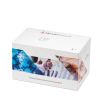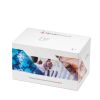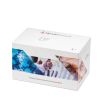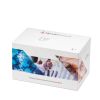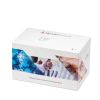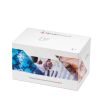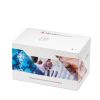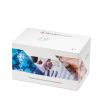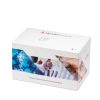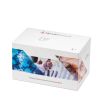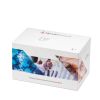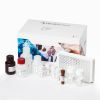HNP1-3, Human, ELISA kit – 1 x 96 det. - HK317-01
Quantity
1 x 96 det.
Catalog #
HK317-01
778,00 €
Human neutrophil defensins (alpha-defensins, HNP1-3) belong to the family of cationic trisulfide-containing microbicidal peptides. Besides microbicidal, the peptides exert chemotactic, immunomodulating and cytotoxic activity and participate in host defense and inflammation. Azurophilic granules of neutrophils contain Human Neutrophil Peptide (HNP)-1-4 which are highly homologous. The three principal human defensins, HNP 1-3, are unique to neutrophils and account for about 99 percent of the total defensin content of these cells. Measured amount of defensins is 3-5 mg per million human neutrophils. Activation of neutrophils leads to rapid release of defensins. Thus, only one cell type, neutrophils, may be the source of HNP1-3 measured in plasma and other body fluids during infection and inflammation. In normal plasma low levels of HNP are present ranging from undetectable level to 50-100 ng/ml, while in septic conditions the levels of HNP might be elevated to 10 mg/ml and even more. Activation of neutrophils in blood as occurs during clotting, as well as long storage of anticoagulated blood leads to a release of HNP, thus careful plasma sampling is important for possible detection of HNP. Defensins are relatively resistant to proteolysis, low pH and boiling, but have a tendency to bind to a variety of materials, including plastic and proteins. The HNP 1-3 ELISA shows cross reactivity with Rhesus monkey HNP 1-3.
| Datasheet URL | https://www.hycultbiotech.com/wp-content/uploads/2022/06/HK317-0816.pdf |
|---|---|
| Quantity | 1 x 96 det. |
| Quantity | 1 x 96 det. |
| Standard range | 156-10,000 pg/ml |
| Detection level | 156 pg/ml |
| Working volume | 100 µl/well |
| Species | human |
| Cross reactivity | Rhesus monkey - Yes |
| Application | The human HNP1-3 (Neutrophil Defensins) ELISA kit is to be used for the in vitro quantitative determination of human HNP1-3 in plasma and cell culture supernatant samples. |
| Principle | The human HNP1-3 ELISA is a ready-to-use solid-phase enzyme-linked immunosorbent assay based on the sandwich principle with a working time of 3½ hours. The efficient format of a plate with twelve disposable 8-well strips allows free choice of batch size for the assay. Samples and standards are captured by a solid bound specific antibody. Biotinylated tracer antibody will bind to captured human HNP1-3. Streptavidin-peroxidase conjugate will bind to the biotinylated tracer antibody. Streptavidin-peroxidase conjugate will react with the substrate, tetramethylbenzidine (TMB). The enzyme reaction is stopped by the addition of oxalic acid. The absorbance at 450 nm is measured with a spectrophotometer. A standard curve is obtained by plotting the absorbance (linear) versus the corresponding concentrations of the human HNP1-3 standards (log). The human HNP1-3 concentration of samples, which are run concurrently with the standards, can be determined from the standard curve. |
| Storage and stability | Product should be stored at 4 °C. Under recommended storage conditions, product is stable for at least six months. |
| Precautions | For research use only. Not for use in or on humans or animals or for diagnostics. It is the responsibility of the user to comply with all local/state and Federal rules in the use of this product. Hycult Biotech is not responsible for any patent infringements that might result with the use of or derivation of this product. |
| References | 1. Zhang, L et al; Contribution of human alpha-defensin-1, -2 and -3 to the anti-HIV-1 activity of CD8 antiviral factor. Science 2002, 298: 995 2. Chang, T et al; CAF-mediated human immunodeficiency virus (HIV) type 1 transcriptional inhibition is distinct from alpha-defensin-1 HIV inhibition. J Virol 2003, 77: 6777 3. Espinoza, J et al; Antimicrobial peptides in amniotic fluid: defensins, calprotectin and bacterial/permeability-increasing protein in patients with microbial invasion of the amniotic cavity, intra-amniotic inflammation, preterm labor and premature rupture of membranes. J Matern Fetal Neonatal Med 2003, 13: 2 4. Nelsestuen, G et al; Proteomic identification of human neutrophil alpha-defensins in chronic lung allograft rejection. Proteomics 2005, 5: 1705 5. Baroncelli, S et al; Characterization of α-defensins plasma levels in Macaca fascicularis and correlations with virological parameters during SHIV89.6Pcy11 experimental infection. AIDS Res Hum Retroviruses 2007, 23: 287 6. Agratti, C et al; Activated Vγ9Vδ2 T cells trigger granulocyte functions via MCP-2 release. J Immunol. 2009, 182: 522 7. Keller, M et al; Phase I Randomized Safety Study of Twice Daily Dosing of Acidform Vaginal Gel: Candidate Antimicrobial Contraceptive. PlosOne 2012, 7:e46901 8. Levinson, P et al; HIV-Neutralizing Activity of Cationic Polypeptides in Cervicovaginal Secretions of Women in HIV Serodiscordant Relationships. PlosOne 2012, 7:e31996 9. Ramma, W et al; The elevation in circulating anti-angiogenic factors is independent of markers of neutrophil activation in preeclampsia. Angiogenesis 2012 10. Savilahti, E et al; Intestinal defensin secretion in infancy is associated with the emergence of sensitization and atopic dermatitis. Clinical & Experimental Allergy 2012 42: 405 |
| Disease | Autoimmunity, Infectious diseases |
| Application assays: | The human HNP1-3 (Neutrophil Defensins) ELISA kit is to be used for the in vitro quantitative determination of human HNP1-3 in plasma and cell culture supernatant samples. |
|---|---|
| Principle: | The human HNP1-3 ELISA is a ready-to-use solid-phase enzyme-linked immunosorbent assay based on the sandwich principle with a working time of 3½ hours. The efficient format of a plate with twelve disposable 8-well strips allows free choice of batch size for the assay. Samples and standards are captured by a solid bound specific antibody. Biotinylated tracer antibody will bind to captured human HNP1-3. Streptavidin-peroxidase conjugate will bind to the biotinylated tracer antibody. Streptavidin-peroxidase conjugate will react with the substrate, tetramethylbenzidine (TMB). The enzyme reaction is stopped by the addition of oxalic acid. The absorbance at 450 nm is measured with a spectrophotometer. A standard curve is obtained by plotting the absorbance (linear) versus the corresponding concentrations of the human HNP1-3 standards (log). The human HNP1-3 concentration of samples, which are run concurrently with the standards, can be determined from the standard curve. |



